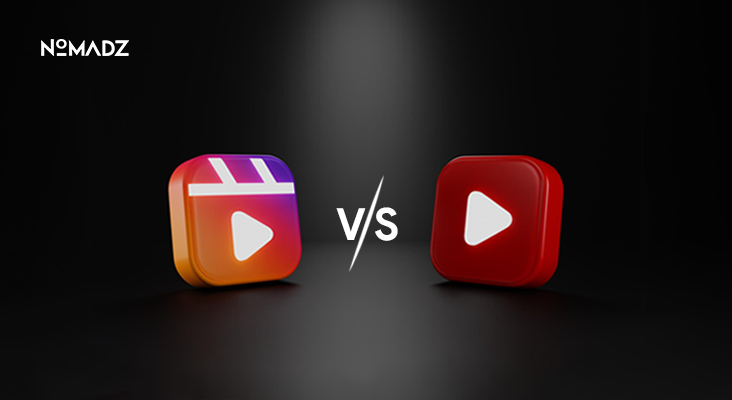Instagram Reels vs. YouTube Shorts: Which Platform Offers Better ROI?
The social media world has been swept by short video content. Programs such as Instagram Reels vs YouTube Shorts have become a real phenomenon, and marketers and businesses have been repeatedly wondering which of these platforms produces better outcomes in terms of social media ROI.
Both platforms have their own comparative advantages, and understanding such differences can help brands make wiser decisions regarding the area in which they want to devote their efforts and financial resources.
What are Instagram Reels and YouTube Shorts?
We will compare them, but first, we need to know what each of these sites offers:
- Instagram Reels: Reels are the answer to Instagram content that is based on short-form videos. The user has the option of creating short videos that are 15 to 90 seconds long using music, effects, and editing tools. Reels are visible in the feeds and Explore pages, and users can also find them in the Reels tab, which makes them highly discoverable.
- YouTube Shorts: YouTube Shorts are up to 60-second-long vertical videos. The shorts are created as a special feed in the mobile devices and can appear in search results and recommendations as well, providing the brand with an opportunity to reach the huge user base on YouTube.
Both sites strive to attract the limited attention of the viewer and get their interest involved. However, they vary in terms of being paid back differently based on the brand objectives.
Also Read: Unilever’s ‘Social-First’ Strategy: A Blueprint for Modern Marketing
Audience Reach and Engagement
The dynamics of the audience between Instagram Reels and YouTube Shorts are different:
Instagram Reels
- Over 1 billion active users.
- The algorithm also boosts Reels, which enhances the possibility of virality.
- Great engagement in terms of likes, comments, and shares.
YouTube Shorts
- Over 2.5 billion active users.
- The system of recommendations promotes repeat viewing.
- Establishes a long-term loyalty of the audience.
Central Argument: Reels are more effective in the short term, while Shorts can be used in the long term.
Monetization Opportunities
The ROI is determined by the revenue-generating content:
Instagram Reels
- Revenues from bonuses and brand deals.
- Shoppable Reels enable users to purchase products in videos.
YouTube Shorts
- Programs of shorts and revenue sharing.
- Redirects watchers to a longer video to make more ad money.
- High-performance ad targeting.
Hint: Select according to your revenue objectives and plan.
Content Creation and Discoverability
The other factor that is significant in the Instagram Reels vs the YouTube Shorts is the simplicity in creating and finding content. Instagram Reels offers built-in editing tools and music libraries, and effects that make it easy to create visually appealing short videos. Its Explore tab also guarantees that the content can be found by new audiences, in spite of the small following of the account.
YouTube Shorts has the advantage of the strong search engine and algorithmic suggestions of YouTube. Video is able to receive long-term exposure, months after publishing. The longer this lasts, the higher the prospective ROI will be since the same video can keep drawing in viewers and converting them in the long run.
Which Platform Offers Better ROI?
Which platform is more profitable to invest in then? The solution will be based on your brand objectives:
- Brand Awareness and Virality: Instagram Reels tend to win in this case. Its algorithm encourages the rapidly growing trend content, providing new accounts with an opportunity to become viral and reach millions in a few seconds.
- Long-Term Viewer Growth and Monetization: YouTube Shorts can be more profitable in this segment. The recommendation system, search discoverability, and monetization opportunities of the platform enable content to keep on getting views, subscribers, and revenue in the long run.
- Direct Sales and E-commerce: Instagram Reels offers more advantages as it has a shoppable element, and businesses can add product links to the short video and make instant sales.
Finally, a combination of both platforms would be able to maximize ROI. The short-form video strategy can be achieved with the help of Instagram Reels, which can be used to create awareness, and YouTube Shorts, which can be used to generate long-term engagement and revenue.
Key Takeaways
Instagram Reels, as well as YouTube Shorts, are essential for short-term videos.
- Reels: The best to be the most viral, engaging, and make sales.
- Shorts: Ideal in terms of long-term growth, monetization, and discoverability.
Integrating the two platforms will make your ROI in social media optimistic.
Also Read: Social Media Creators Overtake Traditional Media in Ad Revenue
Conclusion
Instagram reels vs YouTube shorts debate does not regard one platform as being better than the other. It is concerned with how the various platforms can be strategically used by your brand to attain certain marketing goals. With the knowledge of the strengths of each and the subsequent adaptation of content, businesses can achieve the maximum engagement, reach, and subsequently, ROI on the short-form video content.









Leave feedback about this